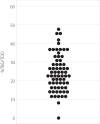Basal insulin requirement in patients with type 1 diabetes depends on the age and body mass index
- PMID: 33740836
- PMCID: PMC8847154
- DOI: 10.1111/jdi.13547
Basal insulin requirement in patients with type 1 diabetes depends on the age and body mass index
Abstract
Aims/introduction: To investigate the basal insulin requirement in patients with type 1 diabetes who are on multiple daily injections (MDI) and to assess the patient characteristics that affect the percent of total daily basal insulin dose to the total daily insulin dose (%TBD/TDD).
Materials and methods: The subjects of this study were 67 inpatients with type 1 diabetes who were served diabetic meals of 25-30 kcal/kg standard body weight during several weeks of hospitalization. The basal insulin requirement was adjusted to keep the blood glucose level from bedtime to before breakfast within a 30 mg/dL difference. The bolus insulin dose before the meal was adjusted to keep the blood glucose level below 140 and 200 mg/dL before and 2 h after each meal, respectively. The total daily insulin dose (TDD), the percent of total daily basal insulin dose (TBD) to TDD (%TBD/TDD), and clinical characteristics were collected.
Results: The median (Q1, Q3) of TDD was 33.0 (26.0, 49.0) units, and the %TBD/TDD was 24.1 ± 9.8%. The %TBD/TDD was positively correlated with the body mass index (BMI) and negatively correlated with the age at the onset and at the examination according to a univariate analysis. However, the %TBD/TDD was dependent on the BMI (β = 0.340, P = 0.004) and the age at examination (β = -0.288, P = 0.012) according to the multiple regression analysis.
Conclusions: The average %TBD/TDD in patients with type 1 diabetes on MDI was approximately 24% under inpatient conditions. The basal insulin requirement was dependent on the BMI and the age at examination.
Keywords: Basal insulin; Multiple daily insulin therapy; Type 1 diabetes.
© 2021 The Authors. Journal of Diabetes Investigation published by Asian Association for the Study of Diabetes (AASD) and John Wiley & Sons Australia, Ltd.
Conflict of interest statement
AK is a member of the Speakers Bureau for Sanofi, Novo Nordisk Inc., and Eli Lilly Japan K.K. MM receives research support from Novo Nordisk Inc., and is a member of the Speakers Bureau for Sanofi, Novo Nordisk Inc., and Eli Lilly Japan K.K. The other authors do not have any potential conflicts of interest relevant to this article.
Figures



Similar articles
-
Carbohydrate-to-insulin ratio is estimated from 300-400 divided by total daily insulin dose in type 1 diabetes patients who use the insulin pump.Diabetes Technol Ther. 2012 Nov;14(11):1077-80. doi: 10.1089/dia.2012.0109. Diabetes Technol Ther. 2012. PMID: 23101953
-
Insulin requirement profiles and related factors of insulin pump therapy in patients with type 2 diabetes.Sci China Life Sci. 2019 Nov;62(11):1506-1513. doi: 10.1007/s11427-018-9530-3. Epub 2019 May 22. Sci China Life Sci. 2019. PMID: 31197759
-
Assessment of factors determining an HbA1c concentration ≤7.5% in patients with type 1 diabetes.J Diabetes. 2018 Feb;10(2):140-147. doi: 10.1111/1753-0407.12572. Epub 2017 Jun 28. J Diabetes. 2018. PMID: 28544548
-
Insulin requirement profiles in Japanese hospitalized subjects with type 2 diabetes treated with basal-bolus insulin therapy.Endocr J. 2015;62(2):209-16. doi: 10.1507/endocrj.EJ14-0487. Epub 2014 Nov 11. Endocr J. 2015. PMID: 25392020
-
Clinical use of U-500 regular insulin: review and meta-analysis.J Diabetes Sci Technol. 2012 Mar 1;6(2):412-20. doi: 10.1177/193229681200600229. J Diabetes Sci Technol. 2012. PMID: 22538155 Free PMC article. Review.
Cited by
-
9. Pharmacologic Approaches to Glycemic Treatment: Standards of Care in Diabetes-2024.Diabetes Care. 2024 Jan 1;47(Suppl 1):S158-S178. doi: 10.2337/dc24-S009. Diabetes Care. 2024. PMID: 38078590 Free PMC article. Review.
-
9. Pharmacologic Approaches to Glycemic Treatment: Standards of Care in Diabetes-2025.Diabetes Care. 2025 Jan 1;48(1 Suppl 1):S181-S206. doi: 10.2337/dc25-S009. Diabetes Care. 2025. PMID: 39651989 Review.
-
Bioelectrical impedance analysis of body composition in children and adolescents with type 1 diabetes: a prospective case-control study.Eur J Pediatr. 2025 Aug 18;184(9):560. doi: 10.1007/s00431-025-06401-4. Eur J Pediatr. 2025. PMID: 40825909 Free PMC article.
-
Intelligent Control with Artificial Neural Networks for Automated Insulin Delivery Systems.Bioengineering (Basel). 2022 Nov 8;9(11):664. doi: 10.3390/bioengineering9110664. Bioengineering (Basel). 2022. PMID: 36354574 Free PMC article.
-
An Overview of Currently Available Injectable Therapies in Diabetes: A Guide to Practitioners.Adv Ther. 2025 Aug;42(8):3634-3656. doi: 10.1007/s12325-025-03250-3. Epub 2025 Jun 7. Adv Ther. 2025. PMID: 40481909 Free PMC article. Review.
References
-
- Todd JA. Etiology of type 1 diabetes. Immunity 2010; 32: 457–467. - PubMed
-
- Schiel R, Burgard D, Perenthaler T, et al. Use and effectiveness of continuous subcutaneous insulin infusion (CSII) and multiple daily insulin injection therapy (MIT) in children, adolescents and young adults with type 1 diabetes mellitus. Exp Clin Endocrinol Diabetes 2016; 124: 99–104. - PubMed
-
- Mochizuki M, Kikuchi T, Urakami T, et al. Improvement in glycemic control through changes in insulin regimens: findings from a Japanese cohort of children and adolescents with type 1 diabetes. Pediatr Diabetes 2017; 18: 435–442. - PubMed
MeSH terms
Substances
LinkOut - more resources
Full Text Sources
Other Literature Sources
Medical

